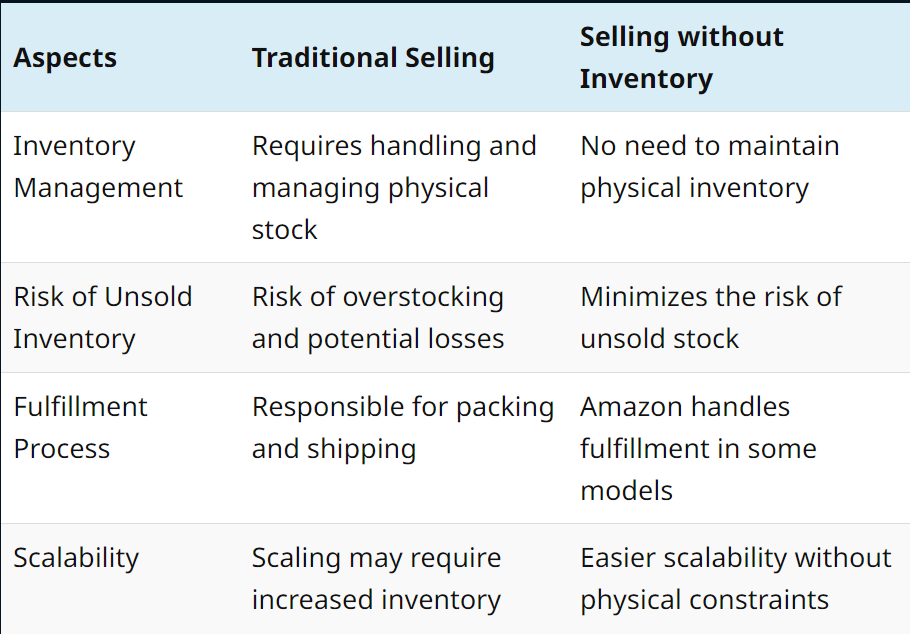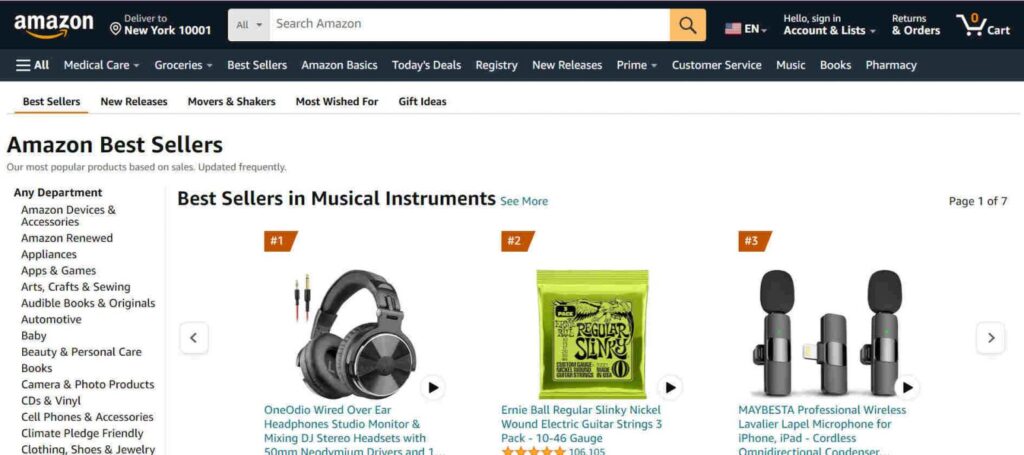Blog
How to Sell on Amazon Without Inventory - An Amazon Seller's Guide

Imagine operating a profitable online shop without requiring a physical warehouse.Doesn’t it sound like a dream?
That dream can become a reality with inventory-free selling on Amazon
No more worries about storage space, packing orders, or shipping logistics. Selling without inventory means you can reach Amazon’s vast audience without the hassle of managing physical stock.
In this article, we’ll discuss how to sell products on Amazon without managing inventory, making it simple for you to start your own business. Let’s get started!
Traditional Selling (with inventory) Vs. Selling Without Inventory on Amazon
This table shows the main difference between traditional selling with and without inventory on Amazon in different areas of business operations

Five Methods to Sell on Amazon Without Inventory
Amazon, being a global marketplace, provides various ways for sellers to sell without the hassle of handling physical inventory. In this guide, we’ll explore five methods for selling on Amazon without inventory.
1.Amazon’s FBA Program
Sellers can leverage Amazon’s vast fulfillment network through the Amazon FBA program, the most straightforward method. With FBA, you send your products to Amazon’s fulfillment center, where they handle storage, packing, and shipping. However, this convenience comes with additional fees for storage and labor. Despite the costs, FBA products are more likely to win the Buy Box, improving sales and rankings. This hands-off approach frees up your time from fulfillment tasks, enabling you to concentrate on strategic business aspects.
Key Players in the FBA Model :
Seller: The entrepreneur who lists products on Amazon and utilizes FBA for fulfillment.
Amazon: The e-commerce giant that provides warehousing, packing, and shipping services.
Customer: The end consumer who purchases products through Amazon.
The FBA Process :
Product Shipment: Sellers deliver their products to Amazon’s fulfillment centers for storage until they’re sold.
Order Processing: When a customer makes a purchase, Amazon takes care of picking, packing, and shipping the product on the seller’s behalf.
Customer Service: Amazon manages customer inquiries, returns, and refunds for FBA orders, simplifying the customer service experience.
Initially requiring inventory, FBA removes the burden of order management and shipping, allowing you to concentrate on marketing and expanding your business.
2.Dropshipping
Dropshipping is a budget-friendly option for new Amazon sellers, offering relief from inventory hassles. It’s a popular choice for starting out without the burden of managing inventory.
With dropshipping, suppliers manage storing, packing, and shipping products to customers directly. Your job is to market and sell these products on your Amazon store.
This innovative approach reduces upfront costs, minimizes logistical challenges, and offers a level playing field for aspiring e-commerce entrepreneurs.
Who are the main players in the dropshipping model?
- Seller: The person who creates an online store and promotes the products.
- Supplier: The company that makes, stores, and ships the products.
- Customer: The individual who buys products from the seller’s online store.
3.Third-Party Logistics (3PL) Company:
Seller: Another method to run an Amazon store without inventory is by teaming up with a Third-Party Logistics company.
They take care of storing and shipping the inventory from their warehouses.
You can integrate your online store with the services offered by the 3PL, ensuring a smooth process. This approach offers flexibility and scalability without requiring a physical warehouse.
However, using a 3PL provider may not be advantageous for all Amazon sellers.
Amazon’s widespread and efficient warehouses allow it to offer competitive prices compared to other companies. In many cases, choosing a third-party logistics (3PL) company can be the most beneficial option, particularly for sellers operating on multiple platforms. It’s important to research and compare the pricing and terms of various 3PL providers to make well-informed decisions about your choices.
Key Players in the 3PL Model
Seller: The individual who delegates logistics tasks to a 3PL provider.
3PL Provider: A logistics company that specializes in storing, packing, and shipping products.
Customer: The end user who buys products on the Amazon platform.
How 3PL Works in Amazon Selling?
Product Storage: Sellers send their items to a 3PL provider’s warehouse for safekeeping.
Order Processing: When a customer makes a purchase, the 3PL provider handles picking, packing, and shipping the product.
Logistics Oversight: The 3PL provider oversees supply chain activities such as inventory management, order fulfillment, and shipping coordination.
4.Kindle Digital Publishing
For those with a knack for writing, Kindle Direct Publishing (KDP) offers an inventory-free avenue.
Writers can self-publish and market e-books on Amazon’s Kindle platform, bypassing the need for physical copies and reaching a global audience. Using KDP, creators can convert their creative content into digital products for Kindle users worldwide.
Key Players in the KDP Model
Author/Creator: The individual who writes or creates digital content for publishing on KDP.
Kindle Users: The readers who access and purchase digital content from the Kindle Store on Amazon.
Types of Content on KDP
E-books: Written content available for download and reading on Kindle devices or Kindle apps.
Paperbacks: Physical book copies produced through KDP Print.
Audiobooks: Authors can release audiobooks via ACX (Audiobook Creation Exchange).
5.Digital Products (Merch on Demand)
Think about the simple method of selling digital products on Amazon without dealing with inventory management.
Digital products take up no physical space, cutting out the need for storage or only requiring computer or cloud storage, which is more economical than warehouse space.
Merch on Demand presents a great opportunity if you’re artistically inclined or have a knack for creating digital products.
This entails designing and selling personalized merchandise like T-shirts, mugs, or phone cases.
Amazon’s Print on Demand services manage production and shipping once customers make purchases.
This approach enables you to monetize your creativity without handling physical inventory.
Key Players in the Merch-on-Demand Model
Creator/Designer: The individual or entity responsible for designing and creating digital artwork for the merchandise.
Amazon Merch Platform: The platform provided by Amazon allows creators to upload their designs, set prices, and make products available.
Customer: The end consumer who purchases custom merchandise through the Amazon platform.
Types of Merch-on-Demand Products
Apparel: T-shirts, hoodies, sweatshirts, and other clothing items.
Accessories: Phone cases, mugs, tote bags, and more.
Home Goods: Pillows, blankets, and other customizable home decor items.
These methods offer flexibility and opportunities for entrepreneurs to engage in e-commerce on Amazon without the complexities of managing physical inventory. Choosing the right method depends on your business model, resources, and preferences.
Step-By-Step Process to Sell on Amazon Without Inventory
Selling on Amazon without inventory involves a step-by-step process. Here’s a breakdown:
Research and Identify Your Niche
Conduct extensive research to find a niche that matches your interests, skills, and market demand.
Look into various categories on Amazon, evaluate competition, and identify products with the potential to succeed.
Select a niche where you can provide value and distinguish yourself.
Select a Dropshipping Approach or Harness Amazon's FBA Program
Choose the inventory-free method that aligns with your business objectives. If you choose dropshipping, build partnerships with trustworthy suppliers to handle order fulfillment. Alternatively, explore Amazon’s Fulfillment by Amazon (FBA) program, allowing Amazon to manage storage, packing, and shipping, while you concentrate on sales and marketing efforts.
Set Up Your Amazon Seller Account
Create an Amazon Seller Account by following the Amazon Seller Central platform registration process.
Choose the appropriate account type (Individual or Professional) based on your business needs.
Complete the necessary details, including business information, tax details, and payment settings.
Optimize Your Product Listings
Create engaging and informative product listings to draw in potential customers. Utilize top-notch images, thorough product descriptions, and precise specifications. Incorporate relevant keywords to improve your product’s visibility in Amazon’s search rankings.
Integrate with Dropshipping Software or Manage FBA Inventory
If adopting the dropshipping model, integrate your Amazon Seller Account with dropshipping software to streamline order processing and inventory management.
For FBA, monitor your inventory levels through Seller Central and replenish stock as needed to prevent disruptions in fulfillment.
Implement Effective Marketing Strategies
Increase your product visibility by applying effective marketing tactics. Utilize Amazon PPC (Pay-Per-Click) ads to attract specific traffic to your listings. Also, employ social media, content marketing, and email campaigns to enhance brand recognition and interact with potential buyers.
Provide Excellent Customer Service
Establish a reputation for exceptional customer service to build trust and loyalty. Respond promptly to customer inquiries and address issues professionally.
Positive reviews and customer satisfaction are critical for long-term success on the Amazon platform.
Monitor and Analyze Performance
Regularly monitor the performance of your products and overall business on Amazon.
To do these, consider a data analytics tool designed to assist Amazon sellers with analytics, insights, and optimization. Utilize this to track sales, customer behavior, and the effectiveness of your marketing efforts.
Adjust your strategies based on the insights gained to optimize your business continually.
You can successfully sell on Amazon without managing physical inventory with these steps.
Five Strategies to Identify Profitable Products to Sell on Amazon

As a seller, it’s crucial to spot lucrative products and navigate Amazon’s vast market successfully.
Here, we’ll delve into five effective tactics to help you pinpoint products that meet market demands and ensure profitable margins for your Amazon business.
1.Use Amazon’s Best Sellers List
A straightforward method to find profitable products is to check Amazon’s Best Sellers List. This list showcases top-selling products in different categories.
Keep an eye on products that consistently rank high, indicating strong demand and popularity. However, always research further to confirm the trend’s sustainability and avoid overly competitive markets.
2.Look for High-Margin Products
While sales volume is crucial, the profit margin on each sale is equally important.
Focus on products with a high profit margin, as this ensures that your revenue covers costs and leaves room for growth. Consider products that offer a good balance between demand and profitability.
Tools like SellerApp FBA calculator can assist in calculating potential fees and estimating your profit margins more accurately
3.Consider Product Size and Weight
Pay attention to the size and weight of the products you intend to sell. Smaller, lighter items often incur lower shipping and storage costs, potentially boosting profit margins.
Additionally, products with favorable size and weight characteristics are more likely to qualify for Amazon’s FBA program, streamlining the fulfillment process.
4.Analyze Product Trends
Staying ahead of market trends is a key strategy in identifying profitable products.
For instance, people increasingly choose travel-sized bottles for convenience and compactness when carrying liquid toiletries like shampoo, lotion, or hand sanitizer on the go. These bottles are crafted for leak-proof functionality, guaranteeing the secure containment of liquids to prevent spills and preserve supplies effectively.
The demand for this product is consistently rising as more individuals are returning to their regular travel routines following a decline in travel during the past couple of years due to the pandemic. With a substantial average monthly revenue and a cost-effective product, this market has lucrative opportunities for profit.
Products with consistent or growing demand are more likely to generate sustained profits.
5.Research Your Competition
In the competitive world of Amazon, understanding your rivals is vital. Begin by thoroughly researching other sellers in your niche. Here’s a systematic approach:
Identify Key Competitors: Find the main players in your niche offering similar products or targeting the same audience.
Analyze Product Listings: Dive into your competitors’ product listings. Pay attention to titles, descriptions, and images, noting highlighted features and value propositions.
Examine Customer Reviews: Read through customer feedback on competitor products to understand what customers like and dislike. Look for common pain points or unmet needs.
This research will provide valuable insights for product selection and marketing strategies. For more details on conducting product research, check out our article.
Conclusion
Selling on Amazon without inventory is possible and offers diverse avenues for entrepreneurs with various skills and interests.
Whether you opt for dropshipping, FBA, teaming up with 3PL providers, publishing digital content, or creating custom merchandise, Amazon offers a platform to bring your business ideas to life without the hassle of handling physical inventory.
Select the approach that suits your skills best, and embark on your inventory-free Amazon journey today.
If you need assistance with that, addMatrix experts can support you with your organic growth strategies.
Request a Callback

Our Clients





























Happy Sellers




Full Service Amazon Marketing Agency
We’re a Amazon Marketing Agency on a mission to give entrepreneurs and brands the push they need to build successful businesses on Amazon.
- Amazon Certified Team
- Amazon Ads Verified Partner
- Join over 1500 happy sellers
- ROI Focus Marketing
- Amazon Global Selling Experts



